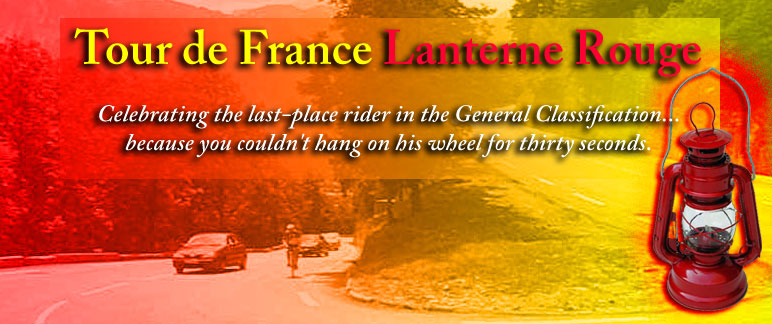Monday, July 18, 2005
2005 Lanterne Rouge article
No shame in being the Tour's caboose
"The French sporting public likes compatriot champions. They also cheer for any countryman in the Tour de France - even if he has no chance of winning but displays perseverance....
Nothing demonstrates this more than the tradition of the lanterne rouge, or red lantern. It's the honor given to the rider who finishes last in the Tour de France overall standings.
Named after the red lantern on the caboose of a train, the lanterne rouge began in the first Tour de France in 1903.
It's never been an official designation, but the last-place cyclist receives his share of admiration.
In recent years, Tour organizers have discouraged any publicity about the red lantern because riders fervently began to abuse its original intention.
Since the second-to-last rider in the final standings wouldn't receive much for his status, back-of-the-pack riders took crafty measures to finish last. They'd hide behind buildings, coast along routes or feign injury to be last.
The last rider doesn't receive prize money for his finish, either. But in yesteryear, it was common for lanterne rouge honorees to receive sizable appearance fees to compete in post-Tour appearance criteriums, the fast-paced races on short, enclosed courses throughout Europe.
"It adds nothing," Jean Marie Leblanc, the retiring Tour de France race director said of the red lantern designation. "Today it is part of the lore of the Tour de France, but it no longer exists officially or unofficially."
Yet the lanterne rouge is still a revered Tour accomplishment.
As the race advances into the Alps and Pyrenees and across the wind-whipped countryside, riders at the bottom of the overall standings face a difficult challenge.
Should they give up and hope for a better race next time or push themselves to an extreme to remain within the varying time limits of each subsequent stage with a goal of finishing last?
In some instances, riders can still receive appearance money to ride in post-Tour criteriums.
"I had a Belgium teammate, and he was the last (rider in the Tour), but he didn't get anything," said Mario Aerts, a Belgian rider ranked in the middle of pack and a safe distance from contesting the lanterne rouge. "But maybe he would have if he were a French guy."
French rider Jimmy Casper, a veteran pro with 24 career victories, has captured the lanterne rouge twice. In the past, on the final day of the race in Paris, Casper capitalized on his status and carried a small red lantern for the purpose of seeking publicity and post-Tour business opportunities.
Some Tour de France riders would rather not hear about or discuss the lanterne rouge.
"I don't care to think about that," Italian rider Gianluca Bortolami said before a recent stage. "For the moment, there are plenty of guys behind me."
Michael Boogerd, the Dutch rider and several-time Tour stage winner, commented he has little time for such a trivial issue. He'd rather concern himself with competing against riders vying for the overall title.
Conversely, Spanish rider Iker Flores has plenty of concern. He's been the current Tour's lanterne rouge for several days.
Riding on the Euskaltel team comprised of Basque cyclists, Flores trails race leader Lance Armstrong by 2 hours, 53 minutes and 59 seconds.
With the difficult climbs of the Pyrenees continuing through Tuesday, Flores is nearly 6 1/2 minutes behind the next-to-last rider.
Whether Flores retains his lanterne rouge status, moves higher among lower-ranked riders, misses a time cut or withdraws via illness or injury, he'll receive increased fan support.
Throngs of Basque fans raucously cheer their countrymen as they meet the challenges of the Pyrenees. They're almost as passionate about the Tour de France as the French, whether their riders are in first or last place."
